Abstract
A study was performed to evaluate the UTIscreen (Los Alamos Diagnostics, Los Alamos, N. Mex.), a rapid bioluminescence bacteriuria screen. The UTIscreen was compared with three other rapid bacteriuria screens: the Bac-T-Screen (Vitek Systems, Hazelwood, Mo.), an automated filtration device; the Chemstrip LN (Boehringer Mannheim Diagnostics, BioDynamics, Indianapolis, Ind.), an enzyme dipstick; and the Gram stain. A semiquantitative plate culture was used as the reference method. Of the 1,000 specimens tested, 276 had colony counts of greater than 10(5) CFU/ml by the culture method. Of these, the UTIscreen detected 96% (265 of 276) using greater than or equal to 5% of the integrated light output of the standard reading as a positive interpretive breakpoint, the Bac-T-Screen detected 96% (266 of 276), the Chemstrip LN detected 90% (249 of 276), and the Gram stain detected 96% (264 of 276). Of the 214 probable pathogens isolated at greater than 10(5) CFU/ml, the UTIscreen detected 95% (204 of 214), the Bac-T-Screen detected 98% (210 of 214), the Chemstrip LN detected 92% (198 of 214), and the Gram stain detected 98% (209 of 214). The predictive values of negative test results at greater than 10(5) CFU/ml for the UTIscreen, the Bac-T-Screen, the Chemstrip LN, and the Gram stain were 98, 97, 93, and 98%, respectively. The overall specificities at greater than 10(5) CFU/ml for the UTIscreen, the Bac-T-Screen, the Chemstrip LN, and the Gram stain were 70, 48, 51, and 69%, respectively. There were 532 specimens with colony counts of >10(3) CFU/ml, and of these, the UTIscreen, the Bac-T-Screen, the Chemstrip LN, and the Gram stain detected 72, 81, 76, and 73%, respectively. Of the 249 probable pathogens isolated at >10(3) CFU/ml, the UTIscreen, the Bac-T-Screen, the Chemstrip LN, and the Gram stain detected 91, 95, 89, and 93%, respectively. The overall specificities at > 10(3) CFU/ml for these methods were 79, 55, 57, and 78%, respectively. The cost per test for detection was approximately $0.50 for the Chemstrip LN. Overall, the UTIscreen is rapid and easy to perform; its sensitivity compared favorably with those of the other screening methods; it had higher specificity than the Bac-T-Screen and Chemstrip LN; and it allowed for bathing of specimen.
Full text
PDF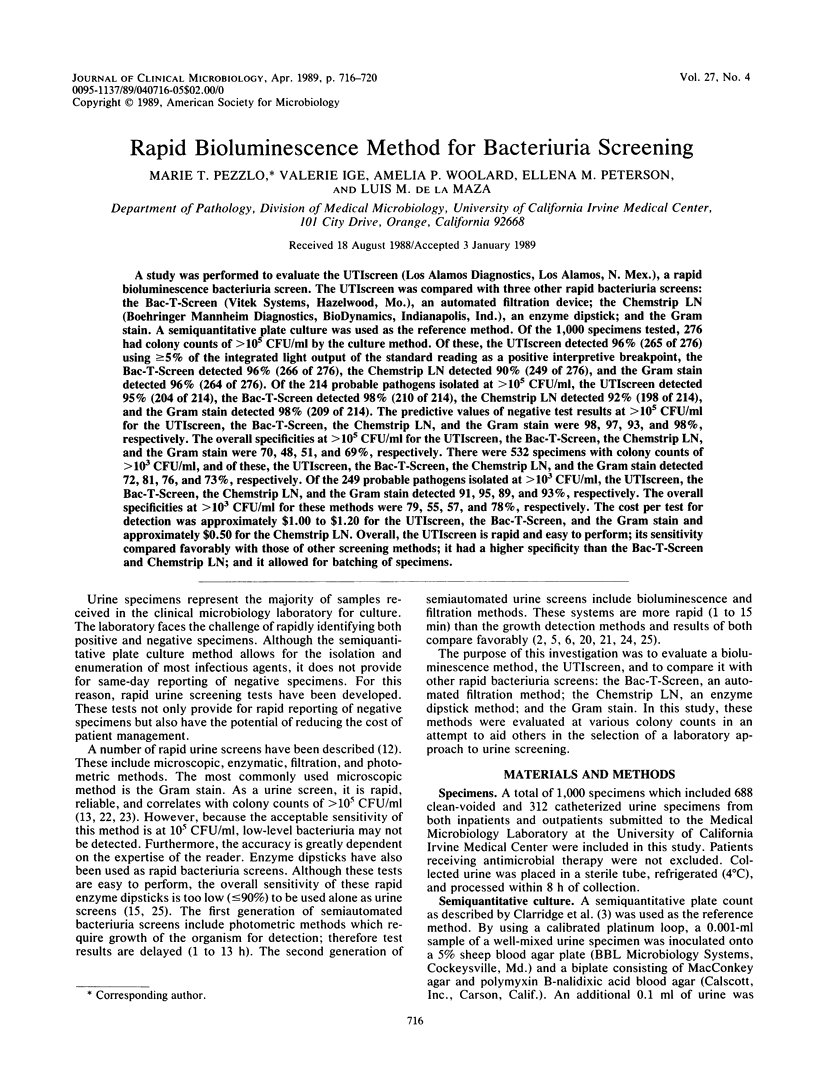
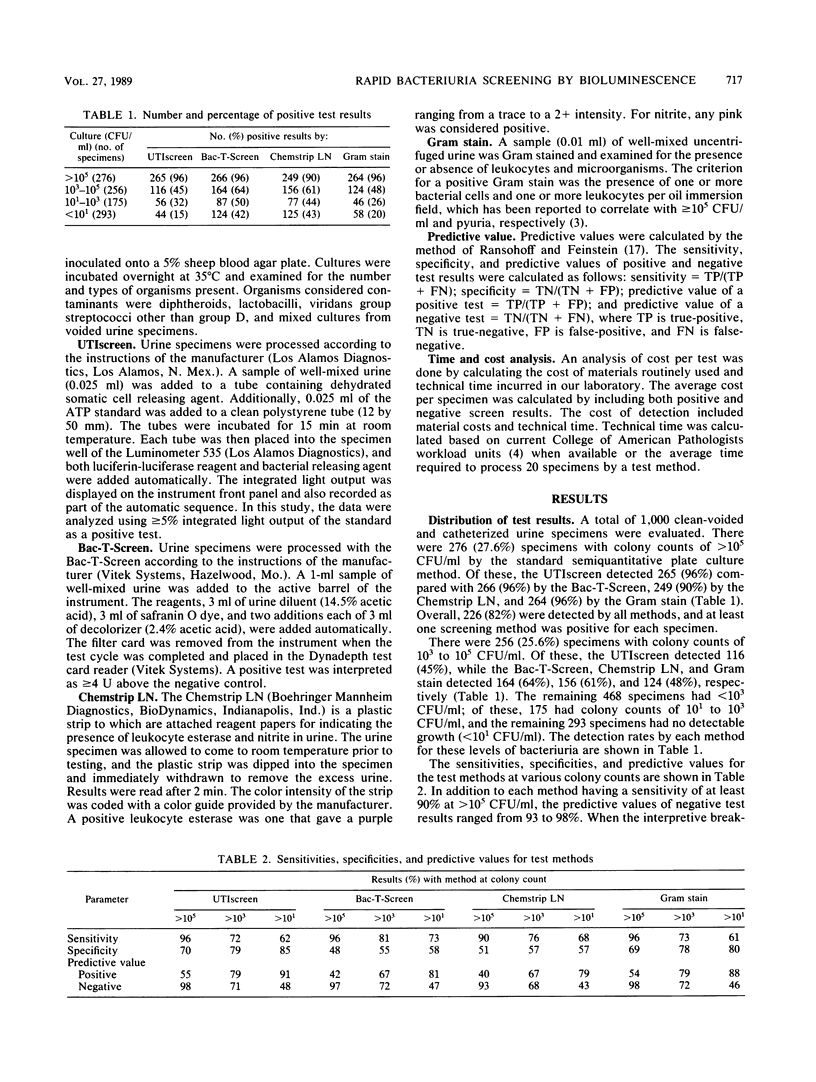
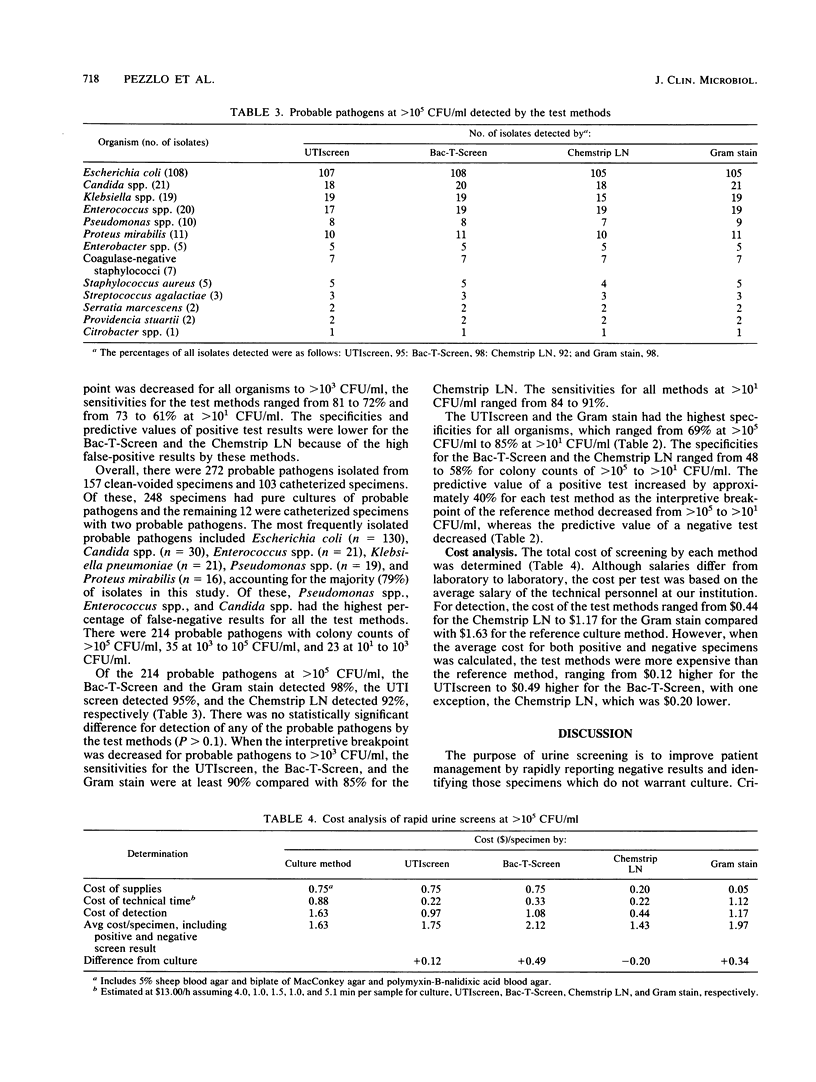
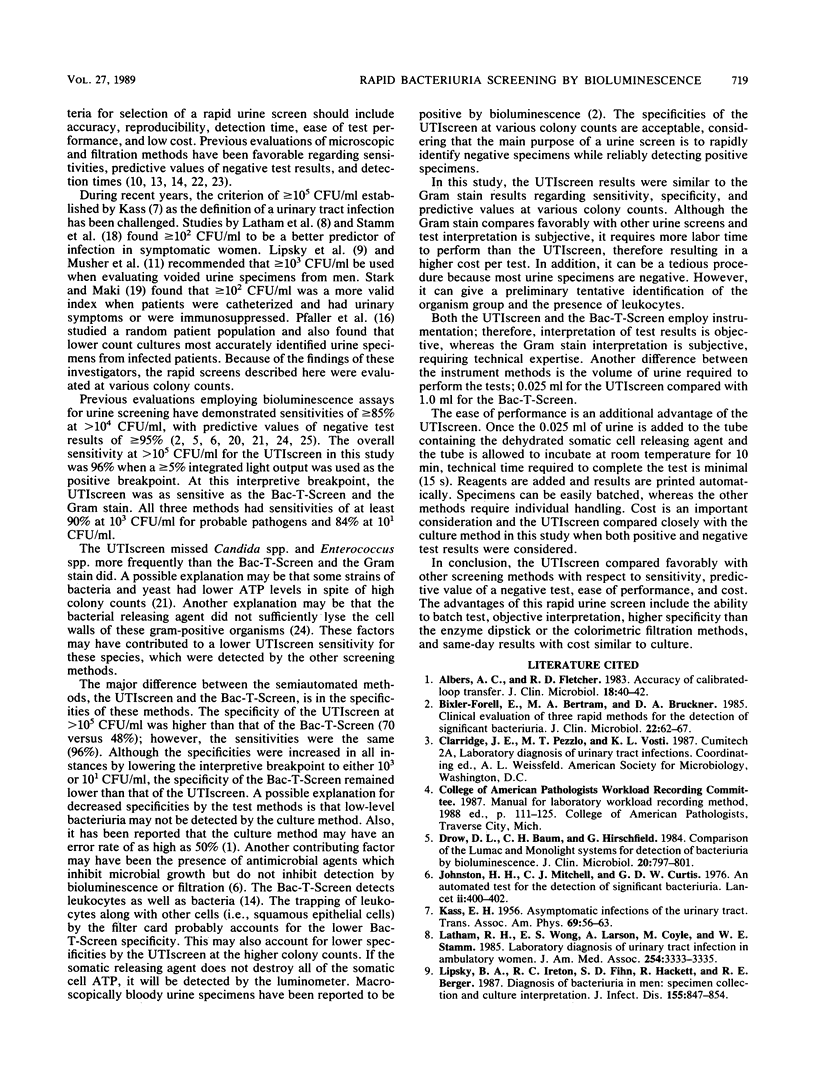
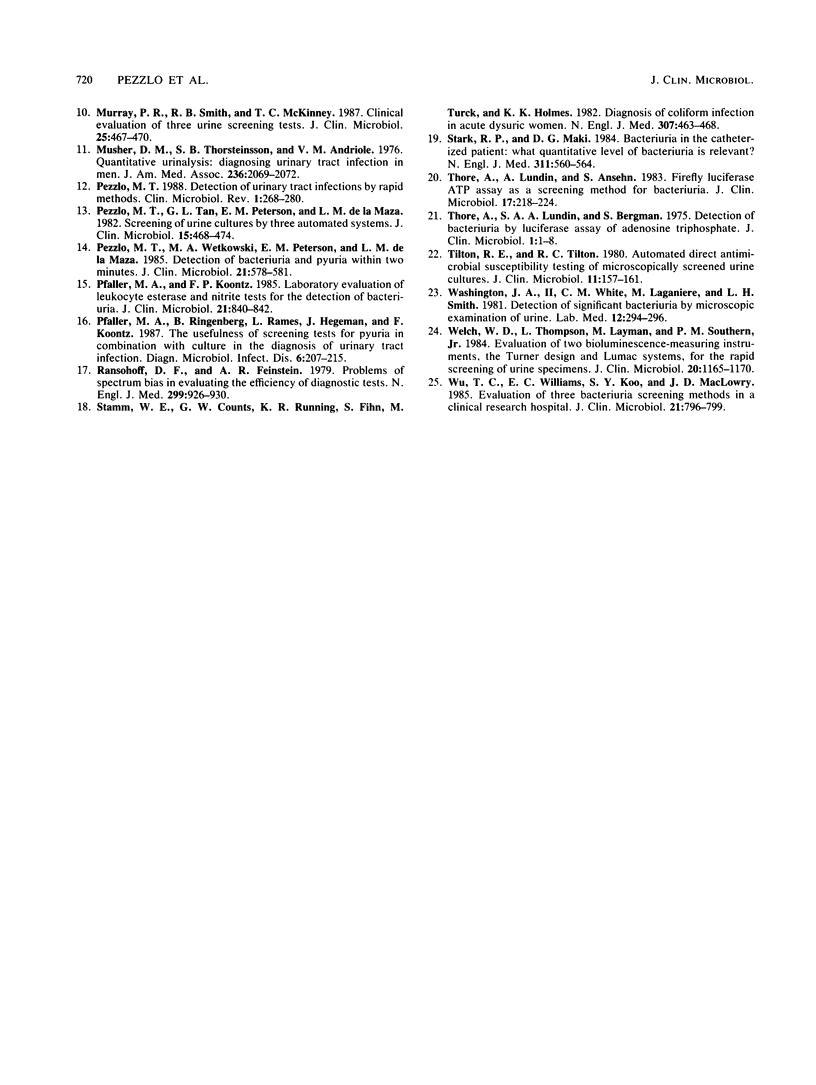
Selected References
These references are in PubMed. This may not be the complete list of references from this article.
- Albers A. C., Fletcher R. D. Accuracy of calibrated-loop transfer. J Clin Microbiol. 1983 Jul;18(1):40–42. doi: 10.1128/jcm.18.1.40-42.1983. [DOI] [PMC free article] [PubMed] [Google Scholar]
- Bixler-Forell E., Bertram M. A., Bruckner D. A. Clinical evaluation of three rapid methods for the detection of significant bacteriuria. J Clin Microbiol. 1985 Jul;22(1):62–67. doi: 10.1128/jcm.22.1.62-67.1985. [DOI] [PMC free article] [PubMed] [Google Scholar]
- Drow D. L., Baum C. H., Hirschfield G. Comparison of the Lumac and Monolight systems for detection of bacteriuria by bioluminescence. J Clin Microbiol. 1984 Oct;20(4):797–801. doi: 10.1128/jcm.20.4.797-801.1984. [DOI] [PMC free article] [PubMed] [Google Scholar]
- Johnston H. H., Mitchell C. J., Curtis G. D. An automated test for the detection of significant bacteriuria. Lancet. 1976 Aug 21;2(7982):400–402. doi: 10.1016/s0140-6736(76)92411-9. [DOI] [PubMed] [Google Scholar]
- KASS E. H. Asymptomatic infections of the urinary tract. Trans Assoc Am Physicians. 1956;69:56–64. [PubMed] [Google Scholar]
- Latham R. H., Wong E. S., Larson A., Coyle M., Stamm W. E. Laboratory diagnosis of urinary tract infection in ambulatory women. JAMA. 1985 Dec 20;254(23):3333–3336. [PubMed] [Google Scholar]
- Lipsky B. A., Ireton R. C., Fihn S. D., Hackett R., Berger R. E. Diagnosis of bacteriuria in men: specimen collection and culture interpretation. J Infect Dis. 1987 May;155(5):847–854. doi: 10.1093/infdis/155.5.847. [DOI] [PubMed] [Google Scholar]
- Murray P. R., Smith T. B., McKinney T. C., Jr Clinical evaluation of three urine screening tests. J Clin Microbiol. 1987 Mar;25(3):467–470. doi: 10.1128/jcm.25.3.467-470.1987. [DOI] [PMC free article] [PubMed] [Google Scholar]
- Musher D. M., Thorsteinsson S. B., Airola VM I. I. Quantitative urinalysis. Diagnosing urinary tract infection in men. JAMA. 1976 Nov 1;236(18):2069–2072. doi: 10.1001/jama.236.18.2069. [DOI] [PubMed] [Google Scholar]
- Pezzlo M. T., Tan G. L., Peterson E. M., de la Maza L. M. Screening of urine cultures by three automated systems. J Clin Microbiol. 1982 Mar;15(3):468–474. doi: 10.1128/jcm.15.3.468-474.1982. [DOI] [PMC free article] [PubMed] [Google Scholar]
- Pezzlo M. T., Wetkowski M. A., Peterson E. M., de la Maza L. M. Detection of bacteriuria and pyuria within two minutes. J Clin Microbiol. 1985 Apr;21(4):578–581. doi: 10.1128/jcm.21.4.578-581.1985. [DOI] [PMC free article] [PubMed] [Google Scholar]
- Pezzlo M. Detection of urinary tract infections by rapid methods. Clin Microbiol Rev. 1988 Jul;1(3):268–280. doi: 10.1128/cmr.1.3.268. [DOI] [PMC free article] [PubMed] [Google Scholar]
- Pfaller M. A., Koontz F. P. Laboratory evaluation of leukocyte esterase and nitrite tests for the detection of bacteriuria. J Clin Microbiol. 1985 May;21(5):840–842. doi: 10.1128/jcm.21.5.840-842.1985. [DOI] [PMC free article] [PubMed] [Google Scholar]
- Pfaller M., Ringenberg B., Rames L., Hegeman J., Koontz F. The usefulness of screening tests for pyuria in combination with culture in the diagnosis of urinary tract infection. Diagn Microbiol Infect Dis. 1987 Mar;6(3):207–215. doi: 10.1016/0732-8893(87)90014-9. [DOI] [PubMed] [Google Scholar]
- Ransohoff D. F., Feinstein A. R. Problems of spectrum and bias in evaluating the efficacy of diagnostic tests. N Engl J Med. 1978 Oct 26;299(17):926–930. doi: 10.1056/NEJM197810262991705. [DOI] [PubMed] [Google Scholar]
- Stamm W. E., Counts G. W., Running K. R., Fihn S., Turck M., Holmes K. K. Diagnosis of coliform infection in acutely dysuric women. N Engl J Med. 1982 Aug 19;307(8):463–468. doi: 10.1056/NEJM198208193070802. [DOI] [PubMed] [Google Scholar]
- Stark R. P., Maki D. G. Bacteriuria in the catheterized patient. What quantitative level of bacteriuria is relevant? N Engl J Med. 1984 Aug 30;311(9):560–564. doi: 10.1056/NEJM198408303110903. [DOI] [PubMed] [Google Scholar]
- Thore A., Anséhn S., Lundin A., Bergman S. Detection of bacteriuria by luciferase assay of adenosine triphosphate. J Clin Microbiol. 1975 Jan;1(1):1–8. doi: 10.1128/jcm.1.1.1-8.1975. [DOI] [PMC free article] [PubMed] [Google Scholar]
- Thore A., Lundin A., Anséhn S. Firefly luciferase ATP assay as a screening method for bacteriuria. J Clin Microbiol. 1983 Feb;17(2):218–224. doi: 10.1128/jcm.17.2.218-224.1983. [DOI] [PMC free article] [PubMed] [Google Scholar]
- Tilton R. E., Tilton R. C. Automated direct antimicrobial susceptibility testing of microscopically screened urine cultures. J Clin Microbiol. 1980 Feb;11(2):157–161. doi: 10.1128/jcm.11.2.157-161.1980. [DOI] [PMC free article] [PubMed] [Google Scholar]
- Welch W. D., Thompson L., Layman M., Southern P. M., Jr Evaluation of two bioluminescence-measuring instruments, the Turner Design and Lumac systems, for the rapid screening of urine specimens. J Clin Microbiol. 1984 Dec;20(6):1165–1170. doi: 10.1128/jcm.20.6.1165-1170.1984. [DOI] [PMC free article] [PubMed] [Google Scholar]
- Wu T. C., Williams E. C., Koo S. Y., MacLowry J. D. Evaluation of three bacteriuria screening methods in a clinical research hospital. J Clin Microbiol. 1985 May;21(5):796–799. doi: 10.1128/jcm.21.5.796-799.1985. [DOI] [PMC free article] [PubMed] [Google Scholar]


